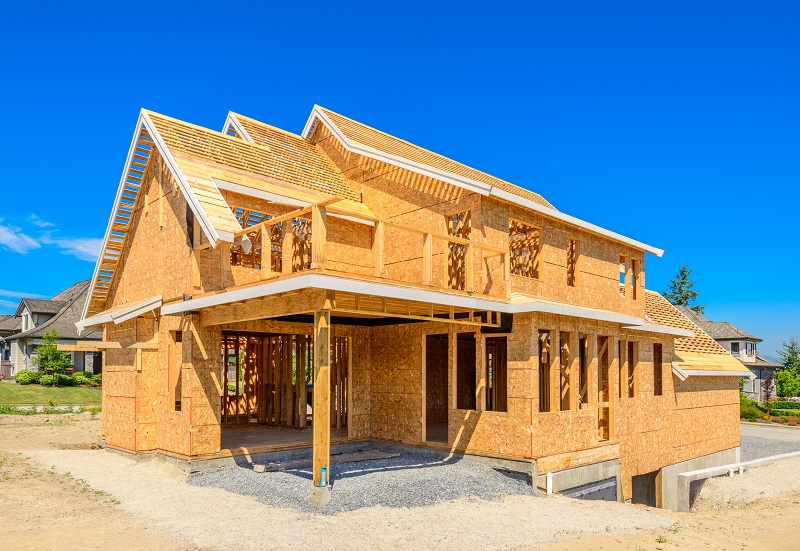New U.S. Homes Are Now Cheaper by the Foot Than Existing Ones
As new construction homes adapt to affordability challenges, they offer a renewed value proposition.

As new construction homes adapt to affordability challenges, they offer a renewed value proposition.

New construction homes commanded a serious premium before the pandemic – from $15 to $22 more per foot than existing homes – but they now represent a relative value. Buyers of new homes got a $3.50 discount per square foot in May compared to those purchasing existing homes. That’s the biggest discount in Zillow median sale price data that stretches back to 2018.
While new-build properties are still selling for about $54,000 more than existing homes, buyers are now seeing savings by the foot nationwide and in 21 major metros – beyond incentives commonly offered by builders. New construction homes in May sold for $209.70 per square foot nationally, just under the $213.20 rate for existing homes.
New builds have only been less expensive per square foot than existing homes in five other months since the start of 2018, and this is the biggest savings seen yet. Builders are offering more price cuts than homeowners selling their own properties. About 29% of new homes received a price cut in June. Meanwhile, more than half of all builders (61%) offer sales incentives other than price cuts, such as mortgage rate buydowns and covering closing costs, which can save buyers thousands of dollars over the first few years of ownership.
Composition considerations
The new construction homes of today, their lot sizes, and the share that are detached vs. condos have evolved over recent years, all contributing to changing the math when comparing prices against existing homes. Today’s new construction buyers are getting significantly smaller lots than those in prior years, and the lot-size advantage of buying existing homes is growing.
Existing home sale prices are up 52% since before the pandemic, while the sale price of new builds has risen by just 26% over the same period.
Zillow listings data shows new construction lots are shrinking far faster than existing ones. The average lot size for new builds is now 460 feet smaller than in 2018 (about the size of a one-car garage), while lots of existing homes shrank by just 94 square feet.
That’s widened the gap in lot sizes between new homes and existing homes. Buyers of existing homes enjoy lot sizes 1,900 square feet larger, on average, than those purchasing new builds – up from a difference of 1,535 feet in 2018.
Land costs continually rise as buildable land becomes more scarce – making more efficient use of the space is one way for builders to make sure housing is still within reach as costs rise.
In May of 2018, new homes that sold were nearly 500 square feet larger than existing homes that sold. But that size advantage shrank in May of 2024 to just 335 square feet.
Home sizes are falling faster for new builds – those sold in May are 185 square feet smaller than in 2018 – the size of a decent bedroom – compared to just a 24-foot drop over the same period for existing homes that sold.
Context is important here. When mortgage rates doubled in 2022, costs skyrocketed for both builders and their buyers, pushing developers to pivot toward smaller units. This is in response to the massive housing shortage and affordability crisis that has pushed homeownership out of reach for many households.
Another explanation for why the gap in price per square foot shrank and – for now – reversed, is that condos and townhomes represent a far smaller portion of new construction sales than they did in 2018. Condos represent just 3% of all the new construction units sold in May 2024, versus 10% in 2018. Condos are significantly more expensive per square foot of living area than single-family units are, so by making up a smaller portion of the mix, price per square foot should ease accordingly.
The more cyclical nature of the existing-home sales season is another factor affecting prices, and price per square foot by extension. Home price growth of existing homes typically peaks in the spring – growth is already cooling down in June from a May peak. Price growth for new-build homes typically has less seasonal variation.
New construction has taken on added importance by providing much-needed inventory while homeowners are still, in large part, locked in to their existing low-rate mortgages. Home construction took off during the pandemic but so far hasn’t made up for years of underbuilding.
The nationwide housing shortage grew to 4.5 million homes in 2022, according to new research from Zillow. Zillow’s latest market report shows the number of existing homes for sale on the market is still 33% below pre-pandemic levels nationally, and the deficit is far greater in many markets.
New build buyers want less hassle, within the budget
About two in five new construction buyers (43%) said the top reason for choosing a new build was that the home was move-in ready, without any need for repairs or updates, according to Zillow’s New Construction Consumer Housing Trends Report.
Affordability and relief from the heat – two top topics of the times – weigh heavily on the minds of buyers when considering their next home’s most important features. A home within their budget was very or extremely important to 89% of new-build buyers – the same share that said the same thing about air conditioning. That a home is energy efficient was the third most important factor.